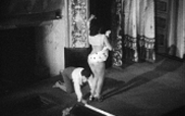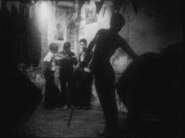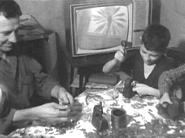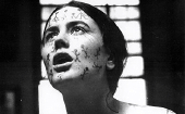 Happy Parallel, 1964. Part of the Morality and Society program in the Clandestí: Forbidden Catalan Cinema Under Franco series, Enric Ripoli i Freixes and Josep Maria Ramon’s Happy Parallel emulates the familiar format of official Noticias Documentales newsreels – the only shot footages of “real life” permitted by Franco under a 1942 ban on non state-sponsored documentary filmmaking – to capture a decidedly more candid, unofficial view of the rhythm of life in El Paralelo, a once bustling entertainment district in Barcelona during the 1920s and 30s that had fallen into hard times after the war. Composed of quotidian street images that were shot over the course of a day, El Paralelo transforms from a seemingly nondescript, working class community by day (in the shots of residents opening windows and heading to work), to notorious red light district by night – the streets dotted with bars, burlesque shows, hourly motels, brothels, and drugstores. But rather than simply illustrating socioeconomic division in the parallel tale of two cities, Ripoli i Freixes and Ramon also reveal through the day to night progression of the images that the disparity is integrally connected to the underlying symptoms of the neighborhood’s dramatic transformation – problems that have been swept under the rug by the regime in an attempt to project its image of conservative and moralistic ideals – poverty (dilapidated buildings), unemployment (a busy pool hall), stagnation, substance abuse, homelessness, and untreated mental illness. Closing with a montage of El Paralelo at daybreak as workers supplant vagrants and the streets are swept clean again, the images express the broader hope of revitalization and transformation through community and hard work.
Happy Parallel, 1964. Part of the Morality and Society program in the Clandestí: Forbidden Catalan Cinema Under Franco series, Enric Ripoli i Freixes and Josep Maria Ramon’s Happy Parallel emulates the familiar format of official Noticias Documentales newsreels – the only shot footages of “real life” permitted by Franco under a 1942 ban on non state-sponsored documentary filmmaking – to capture a decidedly more candid, unofficial view of the rhythm of life in El Paralelo, a once bustling entertainment district in Barcelona during the 1920s and 30s that had fallen into hard times after the war. Composed of quotidian street images that were shot over the course of a day, El Paralelo transforms from a seemingly nondescript, working class community by day (in the shots of residents opening windows and heading to work), to notorious red light district by night – the streets dotted with bars, burlesque shows, hourly motels, brothels, and drugstores. But rather than simply illustrating socioeconomic division in the parallel tale of two cities, Ripoli i Freixes and Ramon also reveal through the day to night progression of the images that the disparity is integrally connected to the underlying symptoms of the neighborhood’s dramatic transformation – problems that have been swept under the rug by the regime in an attempt to project its image of conservative and moralistic ideals – poverty (dilapidated buildings), unemployment (a busy pool hall), stagnation, substance abuse, homelessness, and untreated mental illness. Closing with a montage of El Paralelo at daybreak as workers supplant vagrants and the streets are swept clean again, the images express the broader hope of revitalization and transformation through community and hard work.
 52 Sundays, 1966. On the surface, a film about bullfighting would seem an unlikely source of resistance. But Llorenç Soler’s 52 Sundays is far from a flamboyant celebration of Franco-friendly displays of skill and aggression. Filmed from the perspective of aspiring toreros, often poor, undereducated teenagers from the country who get together on Sundays in makeshift schools on the outskirts of the city to train as bullfighters, the film is instead a sublime and haunting portrait of marginalization. For Felipe, bullfighting offers a way to out of hazardous metalworking, provide respite for his parents, and an opportunity to escape the poverty of the slums. Rafael expresses youthful dreams of social mobility, flashy convertibles, and being able to afford the more high-end prostitutes in El Paralelo (along with altruistic whims of charity). Juan Manuel hopes to return to his village and embellish the town’s modest statues of Jesus Christ and Virgin Mary, as well as build a ranch that will provide well-paying jobs for the community. Juxtaposing shots of the wide-eyed students in training with an actual bullfight, Soler implicitly parallels the fractured, parallel images of young bodies with the formidable presence of the bull in the ring. In a sense, their fates, too, are as intertwined by resilience and determination as it is by the inevitability of defeat – reflected, not as one clean, fatal stab, but after a prolonged struggle of debilitating strikes that lead to broken, exhausted surrender – death coming, not in the heat of battle, but in a crumpled coup de grâce, dragged from the fleeting glory of the arena back into the shadows of obscurity.
52 Sundays, 1966. On the surface, a film about bullfighting would seem an unlikely source of resistance. But Llorenç Soler’s 52 Sundays is far from a flamboyant celebration of Franco-friendly displays of skill and aggression. Filmed from the perspective of aspiring toreros, often poor, undereducated teenagers from the country who get together on Sundays in makeshift schools on the outskirts of the city to train as bullfighters, the film is instead a sublime and haunting portrait of marginalization. For Felipe, bullfighting offers a way to out of hazardous metalworking, provide respite for his parents, and an opportunity to escape the poverty of the slums. Rafael expresses youthful dreams of social mobility, flashy convertibles, and being able to afford the more high-end prostitutes in El Paralelo (along with altruistic whims of charity). Juan Manuel hopes to return to his village and embellish the town’s modest statues of Jesus Christ and Virgin Mary, as well as build a ranch that will provide well-paying jobs for the community. Juxtaposing shots of the wide-eyed students in training with an actual bullfight, Soler implicitly parallels the fractured, parallel images of young bodies with the formidable presence of the bull in the ring. In a sense, their fates, too, are as intertwined by resilience and determination as it is by the inevitability of defeat – reflected, not as one clean, fatal stab, but after a prolonged struggle of debilitating strikes that lead to broken, exhausted surrender – death coming, not in the heat of battle, but in a crumpled coup de grâce, dragged from the fleeting glory of the arena back into the shadows of obscurity.
 Long Journey to the Rage, 1969. imilar to Llorenç Soler’s previous film, 52 Sundays, Long Journey to the Rage is also a sobering portrait of poverty and marginalization. And like the bullfighting students of his earlier film, the people in this film are also anonymous immigrants who have abandoned a hardscrabble existence in the rural provinces in an illusive search of a better life in the city. Unable to find affordable housing, the immigrants pile into overcrowded, dilapidated apartments in rundown districts, paradoxically taking on menial jobs in a construction boom fueled by the transforming cityscape of a rapidly modernized Barcelona that systematically excludes them (a paradox that José Luis Guerín also revisits in his 2001 film, En Construcción). Soler’s incisive sense of juxtaposition creates a remarkably complex and textural work from seemingly mundane images. At times, Soler contrasts rapid-fire images of luxury and conspicuous consumption – advertisements, fashion, high-rise apartment buildings, skyscrapers, fast cars (punctuated by the rhythmic precision of flamenco footwork) – against sobering accounts of exploitation and displacement that reflect the realities of economic polarization. At other times, Soler incorporates culturally iconic music to reinforce the cycle of hardship and desolation: the sound of fados as a family sleeps in a cramped apartment; Aretha Franlkin’s Chain of Fools punctuating the morning commute to the city; a chorale that accompanies the image of homeless people sleeping on a vacant lot, presumably, new immigrants to the city, that cuts to the shot of the church baptism – both reflecting figurative rites of passage into a brave new world of constant struggle and ephemeral moments of grace.
Long Journey to the Rage, 1969. imilar to Llorenç Soler’s previous film, 52 Sundays, Long Journey to the Rage is also a sobering portrait of poverty and marginalization. And like the bullfighting students of his earlier film, the people in this film are also anonymous immigrants who have abandoned a hardscrabble existence in the rural provinces in an illusive search of a better life in the city. Unable to find affordable housing, the immigrants pile into overcrowded, dilapidated apartments in rundown districts, paradoxically taking on menial jobs in a construction boom fueled by the transforming cityscape of a rapidly modernized Barcelona that systematically excludes them (a paradox that José Luis Guerín also revisits in his 2001 film, En Construcción). Soler’s incisive sense of juxtaposition creates a remarkably complex and textural work from seemingly mundane images. At times, Soler contrasts rapid-fire images of luxury and conspicuous consumption – advertisements, fashion, high-rise apartment buildings, skyscrapers, fast cars (punctuated by the rhythmic precision of flamenco footwork) – against sobering accounts of exploitation and displacement that reflect the realities of economic polarization. At other times, Soler incorporates culturally iconic music to reinforce the cycle of hardship and desolation: the sound of fados as a family sleeps in a cramped apartment; Aretha Franlkin’s Chain of Fools punctuating the morning commute to the city; a chorale that accompanies the image of homeless people sleeping on a vacant lot, presumably, new immigrants to the city, that cuts to the shot of the church baptism – both reflecting figurative rites of passage into a brave new world of constant struggle and ephemeral moments of grace.
 Field for Men, 1973. On the other side of the rural exodus captured in Llorenç Soler”s Long Journey to the Rage is Helena Lumbreras and Marià Lisa’s multi-faceted polemic, Field for Men, an exposition on the inequitable systems of landownership and tenancy farming under Franco that perpetuate a cycle of exploitation, unproductivity, and indenture. Wryly prefaced as the fairytale of a bountiful kingdom that once drove away evil forces looking to seize the land, the story is an overt reference to regressive Falangist ideals of returning to the simplicity of an ennobled peasant life. Dismantling the notion of the Second Republic’s 1931 agrarian reform as a simple land grab aimed at seizing generations-old farms (a myth instilled by Franco as justification for his own revolution), Lumbreras and Lisa instead frame the reform in the context of disproportionate private ownership in places like Andalusia, where nearly half of the arable land is owned by less than one percent of the population, leading to such widespread problems as collusive, low wages, mismanagement, and wasted productivity. But beyond the familiar left-leaning calls for solidarity and collectivism, what is perhaps the most compelling argument in the film is the problem of urban migration. Far from the popular notion of campesinos moving to the city for entertainment and leisure, Lumbreras and Lisa instead presciently examine the repercussions of an independent, dual economy system in Franco-era Spain – one driven by a robust (and state-friendly) capitalist system, the other, by a traditional rural economy – that has led to mutually exclusive workforces (and consequently, social classes) that could not be easily integrated with the dissolution of the other: creating a subculture of disenfranchisement and transformational struggle (themes that Jia Zhang-ke would also subsequently capture in his images of modernized China).
Field for Men, 1973. On the other side of the rural exodus captured in Llorenç Soler”s Long Journey to the Rage is Helena Lumbreras and Marià Lisa’s multi-faceted polemic, Field for Men, an exposition on the inequitable systems of landownership and tenancy farming under Franco that perpetuate a cycle of exploitation, unproductivity, and indenture. Wryly prefaced as the fairytale of a bountiful kingdom that once drove away evil forces looking to seize the land, the story is an overt reference to regressive Falangist ideals of returning to the simplicity of an ennobled peasant life. Dismantling the notion of the Second Republic’s 1931 agrarian reform as a simple land grab aimed at seizing generations-old farms (a myth instilled by Franco as justification for his own revolution), Lumbreras and Lisa instead frame the reform in the context of disproportionate private ownership in places like Andalusia, where nearly half of the arable land is owned by less than one percent of the population, leading to such widespread problems as collusive, low wages, mismanagement, and wasted productivity. But beyond the familiar left-leaning calls for solidarity and collectivism, what is perhaps the most compelling argument in the film is the problem of urban migration. Far from the popular notion of campesinos moving to the city for entertainment and leisure, Lumbreras and Lisa instead presciently examine the repercussions of an independent, dual economy system in Franco-era Spain – one driven by a robust (and state-friendly) capitalist system, the other, by a traditional rural economy – that has led to mutually exclusive workforces (and consequently, social classes) that could not be easily integrated with the dissolution of the other: creating a subculture of disenfranchisement and transformational struggle (themes that Jia Zhang-ke would also subsequently capture in his images of modernized China).
 Sexperiencias, 1968. Although allusions to François Truffaut’s Jules and Jim and Jean-Luc Godard’s Breathless suggest José María Nunes’s affection for French New Wave, Sexperiencias finds greater kinship with Nagisa Oshima’s fractured, interconnected themes of sexual and social revolution. In a way, young hitchhiker, María (María Quadreny) is also a stand-in for accidental revolutionary, Motoki in The Man Who Left His Will on Film, a cipher who, in trying to capture the rhythms of everyday life (albeit through photography rather than filmmaking), is politicized by an atmosphere of unrest. Finding momentary connection with an outspoken activist, Antonio (Antonio Betancourt), María’s life is upended when her lover is imprisoned for dissent. Restless and adrift, she embarks on an affair with a nurturing, middle-aged engraver, Carlos (Carlos Otero), only to find her newfound life of comfort and stability at odds with the chaos of the world around her. But while Oshima’s melding of fact and fiction captures the spirit of an internal revolution, Nunes’s revolution is a distant one – a reminder of an empowered other reality that can be turned inward to incite change – galvanized by geopolitical headlines that dominated the local newspapers of 1968: Prague Spring and the Soviet invasion of Czechoslovakia, the assassinations of Martin Luther King Jr. and Robert Kennedy, May 68 protest, the coup in Panama, the turning of the tide in the Vietnam War with Lyndon Johnson’s decision not to seek re-election. Incorporating an incongruous soundtrack of nature sounds, assorted music, and ambient noise, Nunes creates a disorienting environment that is literally out of sync – the separation between image and sound implicitly reflecting the disconnection between the reality of Franco-era Spain and its projected image. Framed against the bookending reference to the U.N.’s adoption of the nonbinding Universal Declaration of Human Rights in 1968, the question of enforcement becomes an ironic coda to the problem of inaction, where the struggle is not in the ability to speak, but in an unwillingness to listen.
Sexperiencias, 1968. Although allusions to François Truffaut’s Jules and Jim and Jean-Luc Godard’s Breathless suggest José María Nunes’s affection for French New Wave, Sexperiencias finds greater kinship with Nagisa Oshima’s fractured, interconnected themes of sexual and social revolution. In a way, young hitchhiker, María (María Quadreny) is also a stand-in for accidental revolutionary, Motoki in The Man Who Left His Will on Film, a cipher who, in trying to capture the rhythms of everyday life (albeit through photography rather than filmmaking), is politicized by an atmosphere of unrest. Finding momentary connection with an outspoken activist, Antonio (Antonio Betancourt), María’s life is upended when her lover is imprisoned for dissent. Restless and adrift, she embarks on an affair with a nurturing, middle-aged engraver, Carlos (Carlos Otero), only to find her newfound life of comfort and stability at odds with the chaos of the world around her. But while Oshima’s melding of fact and fiction captures the spirit of an internal revolution, Nunes’s revolution is a distant one – a reminder of an empowered other reality that can be turned inward to incite change – galvanized by geopolitical headlines that dominated the local newspapers of 1968: Prague Spring and the Soviet invasion of Czechoslovakia, the assassinations of Martin Luther King Jr. and Robert Kennedy, May 68 protest, the coup in Panama, the turning of the tide in the Vietnam War with Lyndon Johnson’s decision not to seek re-election. Incorporating an incongruous soundtrack of nature sounds, assorted music, and ambient noise, Nunes creates a disorienting environment that is literally out of sync – the separation between image and sound implicitly reflecting the disconnection between the reality of Franco-era Spain and its projected image. Framed against the bookending reference to the U.N.’s adoption of the nonbinding Universal Declaration of Human Rights in 1968, the question of enforcement becomes an ironic coda to the problem of inaction, where the struggle is not in the ability to speak, but in an unwillingness to listen.
 Lock-Out, 1973. In its tongue-in-cheek illustration of misguided revolutionaries, Antoni Padrós’s Lock-Out suggests a rough hewn and metaphoric – if more impenetrable and decidedly uneven – precursor to Rainer Werner Fassbinder’s The Third Generation, interweaving episodes of straightforward narrative, dream-like interludes, and political manifesto into an abstract portrait of resistance and marginalization. For former finance worker Walter and his motley group of friends, ground zero for revolution is appropriately found in a salvage yard, where they have set up camp to pursue their own version of Francoist ideals to live off the land – albeit through recycling scrap materials rather than farming. Dropping out of society to lead a bohemian existence, the freedom they had hoped to find in the discarded rubble continues to elude them, their lives complicated by an unexpected pregnancy, romantic rivalries, and boredom. However, when their tedium is broken one day by the unexplained appearance of a handsome stranger who silently watches over them and refuses to leave, the friends decide to abandon their paradise and return to their former lives. Commemorating their return to “civilization” with a celebration, the friends soon discover that their delirious rite of passage is akin to a death ritual. Alternating between commitment and indulgence, absurdity and inanity, Lock-Out is perhaps the most artisanal and demanding installment in the series, where all-too-organic editing decisions to leave in verbal gaffes, miscues, and giggle fits sharply contrast against highly formalized, Bergmanesque shots and swooning pans (in particular, the celebration sequence) that invite germinal comparison to the intoxicated dance in Béla Tarr’s Sátántangó. In hindsight, the captured sense of grotesqueness and dysfunction behind Franco’s conservative ideals is paradoxically lost in the noise, translating as cavalier observation rather than call to action.
Lock-Out, 1973. In its tongue-in-cheek illustration of misguided revolutionaries, Antoni Padrós’s Lock-Out suggests a rough hewn and metaphoric – if more impenetrable and decidedly uneven – precursor to Rainer Werner Fassbinder’s The Third Generation, interweaving episodes of straightforward narrative, dream-like interludes, and political manifesto into an abstract portrait of resistance and marginalization. For former finance worker Walter and his motley group of friends, ground zero for revolution is appropriately found in a salvage yard, where they have set up camp to pursue their own version of Francoist ideals to live off the land – albeit through recycling scrap materials rather than farming. Dropping out of society to lead a bohemian existence, the freedom they had hoped to find in the discarded rubble continues to elude them, their lives complicated by an unexpected pregnancy, romantic rivalries, and boredom. However, when their tedium is broken one day by the unexplained appearance of a handsome stranger who silently watches over them and refuses to leave, the friends decide to abandon their paradise and return to their former lives. Commemorating their return to “civilization” with a celebration, the friends soon discover that their delirious rite of passage is akin to a death ritual. Alternating between commitment and indulgence, absurdity and inanity, Lock-Out is perhaps the most artisanal and demanding installment in the series, where all-too-organic editing decisions to leave in verbal gaffes, miscues, and giggle fits sharply contrast against highly formalized, Bergmanesque shots and swooning pans (in particular, the celebration sequence) that invite germinal comparison to the intoxicated dance in Béla Tarr’s Sátántangó. In hindsight, the captured sense of grotesqueness and dysfunction behind Franco’s conservative ideals is paradoxically lost in the noise, translating as cavalier observation rather than call to action.
Acquarello, 2009 [reprinted]